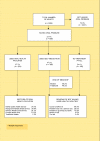Illness-related behaviour and utilization of oral health services among adult city-dwellers in Burkina Faso: evidence from a household survey
- PMID: 17192172
- PMCID: PMC1769368
- DOI: 10.1186/1472-6963-6-164
Illness-related behaviour and utilization of oral health services among adult city-dwellers in Burkina Faso: evidence from a household survey
Abstract
Background: In sub-Saharan Africa, the availability and accessibility of oral health services are seriously constrained and the provision of essential oral care is limited. Reports from the region show a very low utilization of oral health care services, and visits to dental-care facilities are mostly undertaken for symptomatic reasons. The objectives of the present study were to describe the prevalence of oral symptoms among adults in Ouagadougou, capital city of Burkina Faso and the use of oral health services and self-medication in response to these symptoms and to measure the associations between predisposing, enabling and needs factors and decisions to seek oral health care.
Methods: The conceptual design of the study was derived from both the Andersen-Newman model of health care utilization and the conceptual framework of the WHO International Collaborative Study of Oral Health Outcomes. Data were obtained by two-stage stratified sampling through four areas representative of different stages of urbanization of Ouagadougou. The final study population comprised 3030 adults aged 15 years or over and the response rate was 65%.
Results: Overall, 28% of the respondents had experienced an oral health problem during the past 12 months; a high proportion (62%) reported pain or acute discomfort affecting daily life. In response to symptoms, only 28% used oral health facilities, 48% used self-medication and 24% sought no treatment at all. Multivariate analyses revealed that several socio-economic and socio-cultural factors such as religious affiliation, material living conditions and participation in a social network were significantly associated with the use of oral health care services by adults who had experienced oral health problems during the previous year.
Conclusion: The proportion of people who have obtained oral health care is alarmingly low in Ouagadougou and self-medication appears to be an important alternative source of care for adult city-dwellers. Decision-makers in sub-Saharan countries must seek to ensure that access to essential oral health care is improved.
Similar articles
-
Returning home to die or leaving home to seek health care? Location of death of urban and rural residents in Burkina Faso and Senegal.Glob Health Action. 2018;11(1):1475040. doi: 10.1080/16549716.2018.1475040. Glob Health Action. 2018. PMID: 29869949 Free PMC article.
-
Utilization of health care in an African urban area: results from a household survey in Ouagadougou, Burkina-Faso.Soc Sci Med. 1996 Dec;43(11):1611-9. doi: 10.1016/s0277-9536(96)00061-5. Soc Sci Med. 1996. PMID: 8961405
-
[Family environment and dental health disparities among urban children in Burkina Faso].Rev Epidemiol Sante Publique. 2011 Dec;59(6):385-92. doi: 10.1016/j.respe.2011.07.002. Epub 2011 Oct 14. Rev Epidemiol Sante Publique. 2011. PMID: 22000043 French.
-
Assessing the impact of geographical access to health facilities on maternal healthcare utilization: evidence from the Burkina Faso demographic and health survey 2010.BMC Public Health. 2019 Jun 27;19(1):838. doi: 10.1186/s12889-019-7150-1. BMC Public Health. 2019. PMID: 31248393 Free PMC article.
-
Out-of-pocket expenditure and its determinants in the context of private healthcare sector expansion in sub-Saharan Africa urban cities: evidence from household survey in Ouagadougou, Burkina Faso.BMC Res Notes. 2016 Jan 21;9:34. doi: 10.1186/s13104-016-1846-4. BMC Res Notes. 2016. PMID: 26795567 Free PMC article.
Cited by
-
Socioeconomic inequality in dental care utilization in Iran: a decomposition approach.Int J Equity Health. 2019 Oct 22;18(1):161. doi: 10.1186/s12939-019-1072-5. Int J Equity Health. 2019. PMID: 31640703 Free PMC article.
-
Prevalence of oral pain and barriers to use of emergency oral care facilities among adult Tanzanians.BMC Oral Health. 2008 Sep 29;8:28. doi: 10.1186/1472-6831-8-28. BMC Oral Health. 2008. PMID: 18822180 Free PMC article.
-
Barriers to utilization of dental services during pregnancy: a qualitative analysis.J Dent Child (Chic). 2009 Jan-Apr;76(1):46-52. J Dent Child (Chic). 2009. PMID: 19341579 Free PMC article.
-
Systematic review of oral health in slums and non-slum urban settings of Low and Middle-Income Countries (LMICs): Disease prevalence, determinants, perception, and practices.PLoS One. 2024 Nov 8;19(11):e0309319. doi: 10.1371/journal.pone.0309319. eCollection 2024. PLoS One. 2024. PMID: 39514587 Free PMC article.
-
Use of dental care services among adolescents living with HIV on antiretroviral treatment in Kampala, Uganda: a cross-sectional study.BMC Oral Health. 2024 Jun 4;24(1):654. doi: 10.1186/s12903-024-04426-z. BMC Oral Health. 2024. PMID: 38835044 Free PMC article.
References
-
- WHO . World Health Report 2002: Reducing Risks, Promoting Healthy Life. Geneva, ; 2002. p. 230. - PubMed
-
- Petersen PE., Holst, D . Utilization of dental services. In: Cohen LK and Gift HC, editor. Disease Prevention and oral Health Promotion: Socio-dental Sciences in Action. Copenhagen: Munskgaard, ; 1995. pp. 341–386.
-
- Chen M, Andersen RM, Barmes DE, Leclercq MH, Lyttle CS. In: Comparing Oral Health Care Systems, A second international collaborative study. Organization WH, editor. Geneva, ; 1997. p. 350.
-
- Varenne B, Petersen PE, Ouattara S. Oral health behaviour of children and adults in urban and rural areas of Burkina Faso, Africa. Int Dent J. 2006;56:61–70. - PubMed
Publication types
MeSH terms
LinkOut - more resources
Full Text Sources
Medical
Miscellaneous


